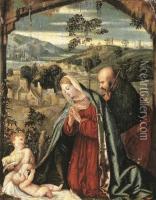Francesco Prata Da Caravaggio Paintings
Francesco Prata da Caravaggio was an Italian painter active during the Renaissance, specifically in the early 16th century. Although not as widely known as his namesake Michelangelo Merisi da Caravaggio, who would come to redefine the Baroque era some decades later, Francesco was nonetheless a significant artist in his own right within the milieu of the Lombard artistic scene.
Francesco was born around 1470 in Caravaggio, a town in the region of Lombardy, Italy. The 'da Caravaggio' in his name indicates his place of origin, a common practice for artists at the time. His early life and training are not well-documented, but it is known that he was active in the town of Crema by 1500 and that he was influenced by the works of more dominant figures of the time, such as Leonardo da Vinci, Vincenzo Foppa, and Bramantino.
The body of work attributed to Francesco Prata da Caravaggio includes altarpieces and frescoes, characterized by their use of color and a delicate handling of figures. His style demonstrates a transition from the Early Renaissance towards the High Renaissance. He was particularly adept at rendering the human figure with a sense of volume and at using perspective, which was a relatively new and evolving technique at the time.
One of his notable works is the 'Madonna and Child with Saints' in the church of San Bernardino in Crema. His art often reflected religious themes, which was typical of the time, as the Catholic Church was a primary patron of the arts. Despite the lack of detailed records about his life and the overshadowing fame of the later Caravaggio, Francesco Prata's contributions to the Lombard school of painting are respected among art historians.
Francesco's exact date of death is uncertain, but it is believed that he died around 1528. The Renaissance was a period of great artistic evolution, and while Francesco Prata da Caravaggio may not have been at the forefront of the movement, his works remain a testament to the rich cultural and artistic environment of Italy during this transformative era.

